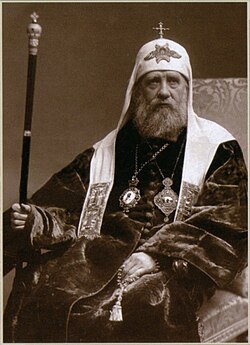Top Qs
Timeline
Chat
Perspective
March 25 (Eastern Orthodox liturgics)
From Wikipedia, the free encyclopedia
Remove ads
March 24 - Eastern Orthodox liturgical calendar - March 26

All fixed commemorations below are observed on April 7 by Orthodox Churches on the Old Calendar.[note 1]
For March 25th, Orthodox Churches on the Old Calendar commemorate the Saints listed on March 12.
Feasts
Saints
- Saint Dismas the Good Thief, crucified next to Christ (1st century)[5][6][7][note 3] (see also: October 12; Good Friday)
- Martyrs Pelagia, Theodosia, and Dula,[8] at Caesarea Palestinae, by the sword (361)[1][9]
- The Holy Martyr who was formerly an executioner.[10]
- Venerable Sennouphios the Standard-bearer, of Latomos Monastery in Thessalonica (9th century)[1][11][note 4]
- Venerable Timon the Hermit (10th century).[12]
Remove ads
Pre-Schism Western saints
- Holy 262 Martyrs of Rome.[5][6][13]
- Saint Quirinus of Tegernsee (Quirinus of Rome), a martyr who suffered in Rome under Claudius II (c. 269)[13][14][note 5]
- Saint Irenaeus of Sirmium, Bishop in Pannonia (Hungary), martyred under Diocletian at Sirmium (Mitrovica) (304)[13][15] (see also: March 26)
- Saint Caimin of Inis Cealtra, Bishop-Abbot of Inis Cealtra and possibly the first Bishop of Killaloe (653)[13][16][17][18][note 6] (see also: March 24)
- Saint Humbert of Maroilles, a disciple of St Amandus who helped found the monastery of Marolles in Belgium (c. 680)[13][19]
- Saint Hermenland (Hermeland, Herbland, Erblon), monk at Fontenelle, ordained priest and sent with twelve monks to establish a new monastery on the island of Aindre (Indret) in the estuary of the Loire (c. 720)[13][note 7]
- Saints Barontius and Desiderius (c. 725)[13][note 8]
- Saint Kennocha (Kyle, Enoch), nun at a convent in Fife, held in great veneration in Scotland, especially around Glasgow (1007)[13][note 9]
- Saint Ælfwold, a monk at Winchester who was chosen as Bishop of Sherborne in 1045 (1058)[13][20]
Post-Schism Orthodox saints
- Saint Nicander, hermit, of Pskov (1582)[1][5][21] (see also: September 24)
- Venerable Parthenius of the Kiev Caves (1855)[1][5][21][22]
- Venerable Savvas the New of Kalymnos (1947)[1][5][21][23] (see also: March 24;[24] April 7 - Greek;[25] the fifth Sunday of Great Lent)
- Saint Justin (Popovic), Archimandrite of Ćelije Monastery in Serbia and Confessor of Traditional Orthodoxy (1979)[1][5][21][note 10] (Old style 25 March, 7 April on new calendar, due to OS Annunciation moved to: June 1)
New martyrs and confessors
Remove ads
Other commemorations
- Greek Independence Day: Proclamation of Greek independence on March 25, 1821, blessed by Metropolitan Germanos III of Old Patras at the Monastery of Agia Lavra..[27][note 12]
Icons
- Synaxis of the Most Holy Theotokos the Burning Bush, on Mount Sinai (Our Lady of the Burning Bush).[30][note 13]
- Synaxis of the Most Holy Theotokos Evangelístria, kept at the monastery of Aliartos in Boeotia.[31]
- Synaxis of the Most Holy Theotokos of Kypera,[note 14] kept at the monastery of the Panagia, on the island of Cephalonia.[32]
- "Annunciation" Icon of the Mother of God (16th century)[5][21]
Remove ads
Icon gallery
- Icon of Annunciation.
(Church of St Clement in Ohrid, 14th century) - Icon of Annunciation.
(Greece, 18th century) - Icon of the Most Holy Theotokos the Burning Bush.
- St. Dismas the Good Thief in the Bosom of Abraham.
- St. Dismas the Good Thief (c. 1560).
- Skull (relic) of St. Humbert of Maroilles.
- Venerable Parthenius of the Kiev Caves.
- New Hieroconfessor Tikhon, Patriarch of Moscow and all Russia.
- New Hieroconfessor Tikhon, Patriarch of Moscow and all Russia.
- Saint Justin (Popovic).
- Proclamation of Greek Independence on March 25, 1821.
Remove ads
Notes
- The notation Old Style or (OS) is sometimes used to indicate a date in the Julian Calendar (which is used by churches on the "Old Calendar").
The notation New Style or (NS), indicates a date in the Revised Julian calendar (which is used by churches on the "New Calendar"). - Venerable Sennouphios was an ascetic of Nitria, who saw a vision of an icon of our Lord Jesus Christ, Who instructed him to go to Latomos Monastery in Thessalonica, where he would see this same icon.
- "At Rome, St. Quirinus, martyr, who after losing his goods, suffering imprisonment in a dark dungeon, and being severely scourged, was put to death with the sword, and thrown into the Tiber. The Christians found his body in the island of St. Bartholomew and buried it in the Pontian cemetery."[6]
- An ascetic who lived as a hermit on an island in Lough Derg in Ireland. Many disciples were attracted to him on account of his holiness. Later he founded a monastery and church on the island of the Seven Churches and worked with St Senan. A fragment of the Psalter of St Caimin, copied in his own hand, still exists.
- Barontius became a monk at Lonrey near Bourges in France. As a result of a vision he became a hermit, set out for Italy, and settled near Pistoia. There he lived very ascetically with another monk, called Desiderius, who is also honoured as a saint.
- See also: Rev. Alban Butler (1711–73). St. Kennocha, Virgin in Scotland. The Lives of the Saints. Volume III: March. 1866. (Bartleby.com).
- His service is celebrated on September 26.[1]
- The Greek revolt was precipitated on March 25, 1821, when Bishop Germanos of Patras raised the flag of revolution over the Monastery of Agia Lavra in the Peloponnese. The cry "Freedom or Death" became the motto of the revolution.[27]
Some European newspapers of June and July 1821 published news of a declaration of revolution by Germanos either in Patras on 6 April/ 25 March 1821[28] or in the "Monastery of Velia Mountain" (Agia Lavra) on a non specified date.[29] - The icon of the Most Holy Theotokos of the Burning Bush is commemorated at Saint Catherine's Monastery on Mount Sinai.
Remove ads
References
Sources
Wikiwand - on
Seamless Wikipedia browsing. On steroids.
Remove ads










